Dental problems in dogs
Overview
Symptoms
Risks
Diagnosis
Vet treatment
Home treatment
Prevention
When to worry
Dental problems in dogs
Dental disease is the most common health problem affecting UK dogs. In fact, around 80% of UK dogs have teeth and gum problems. 12.5% of dogs who have to see a vet go because of dental problems. Dental disease can happen in dogs of any breed, sex or age, but it’s most common in older dogs and breeds with short faces.
Some dental problems start before birth, while a puppy is still in the womb. Other problems may develop at any time throughout your dog's life. Common problems include poorly aligned teeth, dental decay and trauma. Unidentified and untreated dental disease causes pain and suffering for many dogs. A healthy diet, daily dental care and regular check-ups with a vet help your dog have a healthy mouth and a better quality of life.
What is dental disease in dogs?
Teeth and teething in dogs
Dogs are born without teeth, their baby teeth come in between 3 and 6 weeks old.
Baby teeth fall out as adult teeth come in.
Adult teeth are all present by 6-7 months old.
All dogs have 28 baby teeth and 42 adult teeth.
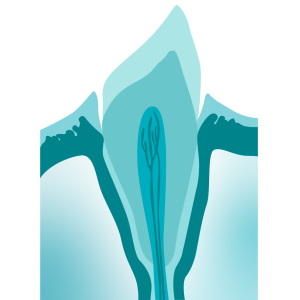
Types of dental problems
1. Dental problems from birth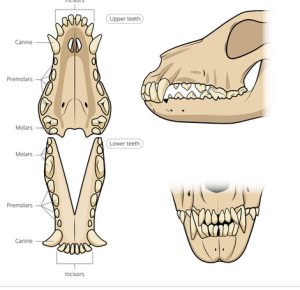
Properly aligned teeth are crucial for dogs to avoid gum damage and chewing issues. Some dogs inherit overcrowded teeth or jaw abnormalities. Breed problems and birth defects include:
Overcrowding: All dogs have the same number of adult teeth, but in short-faced breeds (like pugs), the smaller jaw gives less room, so teeth often sit at odd angles or overlap.
Malocclusion: When the upper and lower teeth don’t align properly, causing an uneven bite.
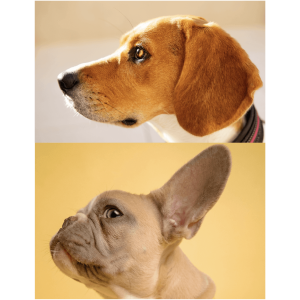
Broken teeth: from accidents, biting into hard objects such as antlers, bones or kennel bars.
Worn teeth: chewing on stones or even tennis balls.
Weakened teeth: caused by medicines that damage the developing tooth given to a young puppy or to their mum during pregnancy, serious illness affecting mum in pregnancy or poor maternal diet.
Dogs on a healthy diet don't eat sugar and sweets the way humans do, so they aren't prone to the cavities (caries) and decay that this causes in humans. However, tooth decay is still a problem in dogs and can result from any or all of the following:
Bacteria from rotting food particles trapped between teeth.
Eating the wrong things, especially sugary human food.
Poor dental care.
Tooth root abscesses.
Overgrowth of gum tissue around the tooth: triggered by decay and also a cause of decay, as it traps bacteria between the gum and the tooth.
Other illnesses: chronic kidney disease and cancer, especially cancers of the gum or jaw.
Labradors get caries in their molars (large back teeth) due to an inherited problem rather than a bad diet. They’re often only spotted in a routine exam.
The process of tooth decay in dogsBacteria in the mouth grow on the surface of the tooth to form a layer of plaque.
Plaque is hard to remove from teeth. Chewing and tongue movements can help to break plaque down. But poor diet and poor dental care will worsen the situation.
Dental calculus (also called tartar or scale) forms when plaque hardens on the tooth, creating a rough surface which attracts even more bacteria.
Acid produced by the bacteria and plaque attacks teeth.
Gingivitis: Red and inflamed gums when plaque bacteria get onto the gums. Gingivitis is usually the first warning sign of tooth decay.
Periodontal disease: decay affects the gums and other structures which support and anchor the tooth.
How will I know if my dog has dental problems?
Dogs may not show any obvious symptoms in the early stages of dental disease. For this reason, problems are often well-established by the time they are identified.
Symptoms of dental problems will relate to poor chewing function, tooth decay and pain. For example:
Eating soft food and leaving kibble
Dropping food, eating on one side of the mouth, and dribbling saliva
Halitosis (smelly breath)
Rubbing or pawing at the mouth
Facial swelling over a tooth abscess
Losing weight
Becoming quiet and withdrawn
What are the risks of dental problems?
Various life stages, breed and lifestyle factors affect your dog's risk of having dental problems. These include:
Increasing age
Small breeds: Poodles, Yorkshire Terriers, and Chihuahuas
Brachycephalic breeds: Bulldogs, Pugs, Cavalier King Charles Spaniels, Boxers, Shih Tzus, with teeth overcrowded in a short upper and lower jaw
Poor alignment of teeth
Eating a poor-quality diet
Chewing stones, kennel bars or other hard surfaces
Retaining baby teeth: most common in brachycephalic and small breeds (Yorkshire Terriers)

Complications of dental disease
Overcrowding and malocclusion increase the risk of:
Broken teeth
Trapped food and tooth decay
Gum damage
Pain and problems eating
Poor quality of life
Undiagnosed and untreated dental disease can lead to other serious and life-threatening illnesses. This happens when bacteria from the affected teeth and gums spread through the blood or airways to other parts of the body. Disease risks include:
Chest infections and bronchopneumonia
Septicaemia
Damaged heart valves and muscle due to bacterial endocarditis
How do vets diagnose dental problems in dogs?
Dogs rarely let their owners know if they have tooth problems. So they may only be discovered at routine health checks, which pick up visible changes such as staining, inflammation or missing teeth.
Because many problems can’t be assessed while your dog is awake, your vet may recommend a general anaesthetic. This allows a full examination, and if needed, dental surgery at the same time. Additional tests pick up changes not seen on surface inspection:
Dental x-rays to examine the roots of teeth and the jawbone that anchors them
CT scan for complex problems
What's the treatment for dental disease?
Treatment depends on the type of dental disease present and its severity.
1. Birth defects and misaligned teeth
For brachycephalic breeds, malaligned and crowded teeth are such a feature of the breed shape that potential problems can't be completely cured or prevented as a puppy. For dogs with an individual overbite or misplaced canines, various options can be considered.
Treatment options include:
Encouraging your dog to carry a special-sized ball to push teeth into the correct alignment as they continue to erupt.
Removing teeth that damage gums or other teeth. The tooth removed may be otherwise healthy.
Flattening the tips of the teeth, called crowns, to reduce gum injury.
2. Injured teeth
This depends on whether the injury allows infection into the tooth. Treatment may include:
Monitoring: if the tooth is simply discoloured or blunted.
Extracting a fractured or loosened tooth.
More specialist techniques or canine orthodontic treatment, such as dental fillings and crowns.
3. Tooth decay
Treatment options for tooth decay include some or all of the following, under a general anaesthetic:
Extracting loose or decayed teeth.
Scaling: removing all the lumps of hard scale with an ultrasonic scaler and handheld dental tools.
Cleaning and polishing the remaining teeth and gums thoroughly to give the mouth a fresh start.
Removing teeth with deep caries: Labradors.
How to help your dog with their dental problems
If your dog has dental problems, they should see their vet for a full examination. Your vet will be able to advise on treatment that is safe and in your dog’s best interests.
If your dog is experiencing dental problems:
Call your vet for the next available appointment.
Feed smaller, more frequent meals of soft food.
Encourage your dog to drink as much as possible, even if they refuse food.
After dental surgery:
Keep your dog's teeth clean after a dental operation.
Start brushing immediately to prevent plaque and bacteria from returning. This can happen within 24 hours of dental work.
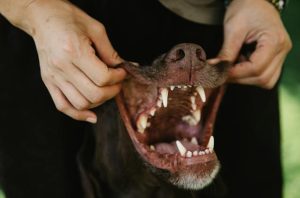
How to reduce or prevent dental problems in dogs
The risks of dental decay in later life can be dramatically reduced if you start cleaning your dog’s teeth when they’re as young as possible. Preventing dental disease is far more cost-effective than treating it once it develops.
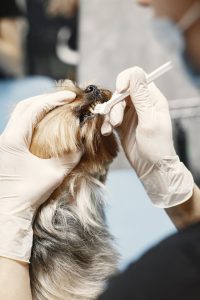
Feed your dog a complete, well-balanced diet, steering clear of sugary, sweet human treats.
Brush your dog's teeth daily: It’s never too late or too early to start brushing your dog’s teeth. Brush every tooth (including the back molars), focusing on the inner tongue-side surfaces and especially the gumline where plaque and bacteria build up first.
Consider a dental health or prescription diet, whose components and kibble shape help keep teeth in top condition.
Dental chews & treats: Chewing helps remove plaque and scale, but some edible chews are high in fat or calories. Check feeding instructions or ask your vet if your dog has health conditions.
Using a dental mouthwash, gel, spray or rinse may be beneficial for dogs who won't tolerate brushing
The Veterinary Oral Health Council awards a seal of approval to dental products which effectively slow down plaque and tartar formation.
Protecting future generations
Living with dental problems is challenging and painful. Many dental problems are inherited. They pass from mum or dad to the puppy before it’s born. Fewer puppies and dogs will have these dental problems if we avoid breeding from dogs with dental problems. This includes breeding dogs with faces too short to hold the teeth.
When to worry about dental problems in dogs
Call a vet if your dog:
Has facial swelling and poor appetite after a blow to the face
Has unexplained bleeding from their mouth
Is physically unable to pick up food or chew
Is distressed, pawing at their face and unable to settle
Joii can help with advice on:
Recognising the symptoms of dental disease
Brushing your dog's teeth
Alternatives to brushing
Choosing age-appropriate chew toys and diets























